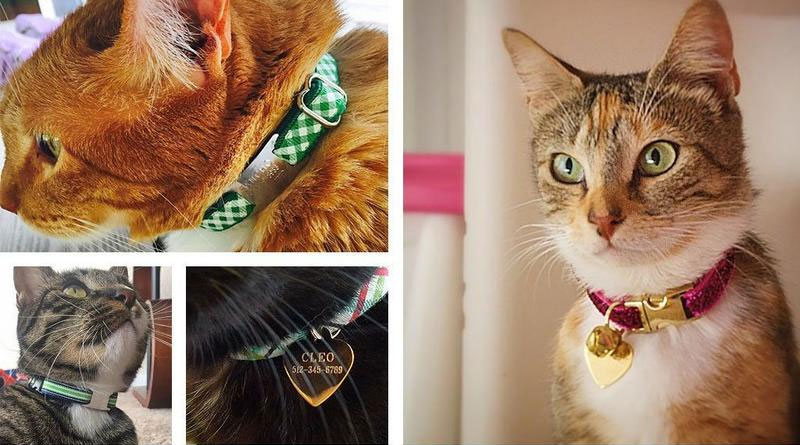Your Cart is Empty
The Importance of Pet ID Tags
by Alex Harmon
The Importance Of Pet I.D. Tags
One of the biggest things that we stress to our customers is the importance of having visible identification on your pet. If you’re like us, your pets are members of your family and you would do anything to make sure they’re safe at home with you. As such, putting an ID tag on your pet’s collar is a small way to make a big impact on your pet’s safety.
Still, there are many out there who forego an ID tag for several reasons. We’d like to highlight a few below to show you how these justifications often underscore why a tag is so important:
#1: "I have an indoor-only cat"
This is the most common excuse we hear, and ironically, it happens to be the best reason for your pet to wear a collar with an ID tag. While indoor/outdoor cats or outdoor-only cats tend to already be familiar with the area near one's home and what home your looks like from the outside (as well as the landmarks that lead to their home), indoor-only cats do not. If your indoor-only cat escapes and gets outside for any reason, he/she will almost certainly be disoriented, less prepared for the unprotected environment, and the chances of getting lost are high. For this reason, it's very important to have visible identification on your indoor-only cats so they can be safely returned when found.
#2: "My pet won’t go far if he/she gets out of the house"
This one is based in truth, but is incorrectly used as a justification for lacking ID. An indoor/outdoor cat will generally only go a small radius away from their home in normal circumstances. However, there are many reasons why your cat may stray. If another animal is chasing it, or if they are tempted to go further away due to the smell of food or the sound of a calling animal, this rule of thumb breaks down. Once a cat leaves its familiar radius, it may have difficulty finding its way back. An ID tag is crucial in these cases.
#3:"My cat won't wear collars"
As frustrating as it can be to get a pet adjusted to wearing a collar, they generally get used to it after a few days, and it's well worth the sometimes awkward adjustment period. Once a cat has grown accustomed to the feeling of wearing a collar, their general level of safety is greatly improved. They will not only be able to wear ID tags attached to their collars, but may also wear bells if you wish to know where the cat is as they walk. Cats are known for silently sneaking up by your legs, and a small bell may help you hear your cat so you can avoid accidentally stepping on or kicking him/her. (A quick note about bells — we recognize that the discussion about whether or not cats are better off wearing bells for safety is a contentious topic. Fortunately, it's an entirely optional thing that those in favor of bells, can use and benefit from, while others can opt to leave the bell off the collar. Neither stance is wrong. The most important thing is that the collar include some form of obvious ID attached to it for others to act upon (should they find your pet lost outdoors).
Tip: Cats are far more likely to adapt to wearing a collar when the collar fits well (i.e. snug but comfortable, with enough room to fit 2 fingers between the neck & collar) and doesn't hang down too loosely. An overly loose collar is not only dangerous but can be extremely distracting for the pet and they are much more likely to scratch at it and try to remove it. Also - for cats who REALLY seem to fight the idea of wearing a collar -- you may want to consider leaving the bell off and choosing a flat, non-hanging style of ID tag instead of the conventional kind that dangles on the pet's neck. This type of tag, called a "slide ID tag" is noiseless and a popular choice for customers with cats who are new to wearing collars. You can find this option available here in a couple of polished metal colors.

#4 "But my cat is microchipped"
Microchipping is a great way for lost pets to be identified if they've already been taken to a shelter or veterinary clinic. We highly recommend getting your pet microchipped as a backup, in case they end up outside without their collar on. However, it's very likely that a lost pet will be found by a person in your neighborhood first, and it's highly unlikely that they will have a way to scan the microchip. As such, your pet may be assumed to be a stray and may be taken in by someone else, without even a thought or consideration about the microchip. Also, consider a scenario where your pet becomes stuck in a neighbor's garage or yard. If the neighbor sees an ID tag on your pet, they can call you or take your pet back to your house – after all, it may be a short walk or drive to do so. Without an ID tag, a common inclination is to simply let the animal go free outside and hope it finds its way back home.
One last word on microchips: a 2009 study showed that while microchipped cats brought to shelters were returned to their owners 38.5% of the time, most of the time the remaining cats weren't returned because of missing or incorrect information associated with the microchip. So please, make sure your microchip information is up-to-date and correct!

Knowing all this information, please make sure your pet has an ID tag to ensure he/she always has a ticket to get back home, safe & sound with you. Made By Cleo offers many styles of custom engraved ID tags starting at $7.95, which you can find here, along with hundreds of collar options as well. Orders ship fast - within 1-3 business days.

Subscribe to our BLOG & NEWSLETTER
Sign up for our email newsletter so you don't miss our next blog post, sale or new product announcements!

